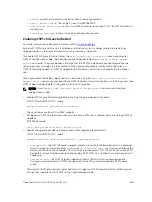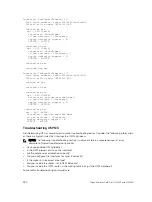
command to create the OSPF process, then the
network area
command to enable OSPF on an
interface.
NOTE: The OSPFv2
network area
command enables OSPF on multiple interfaces with the single
command. Use the
OSPFv3 ipv6 ospf area
command on each interface that runs OSPFv3.
All IPv6 addresses on an interface are included in the OSPFv3 process that is created on the interface.
Enable OSPFv3 for IPv6 by specifying an OSPF process ID and an area in INTERFACE mode. If you have
not created an OSPFv3 process, it is created automatically. All IPv6 addresses configured on the interface
are included in the specified OSPF process.
NOTE: IPv6 and OSPFv3 do not support Multi-Process OSPF. You can only enable a single OSPFv3
process.
Enabling IPv6 Unicast Routing
To enable IPv6 unicast routing, use the following command.
• Enable IPv6 unicast routing globally.
CONFIGURATION mode
ipv6 unicast routing
Assigning IPv6 Addresses on an Interface
To assign IPv6 addresses to an interface, use the following commands.
1.
Assign an IPv6 address to the interface.
CONF-INT-type slot/port mode
ipv6 address
ipv6 address
IPv6 addresses are normally written as eight groups of four hexadecimal digits; separate each group
by a colon (:).
The format is A:B:C::F/128.
2.
Bring up the interface.
CONF-INT-type slot/port mode
no shutdown
Assigning Area ID on an Interface
To assign the OSPFv3 process to an interface, use the following command.
The
ipv6 ospf area
command enables OSPFv3 on an interface and places the interface in the
specified area. Additionally, the command creates the OSPFv3 process with ID on the router. OSPFv2
requires two commands to accomplish the same tasks — the
router ospf
command to create the
OSPF process, then the
network area
command to enable OSPFv2 on an interface.
NOTE: The OSPFv2 network area command enables OSPFv2 on multiple interfaces with the single
command. Use the OSPFv3
ipv6 ospf area
command on each interface that runs OSPFv3.
578
Open Shortest Path First (OSPFv2 and OSPFv3)
Summary of Contents for Z9000
Page 1: ...Dell Configuration Guide for the Z9000 System 9 7 0 0 ...
Page 80: ...grub reboot 80 Management ...
Page 128: ... 0 Te 1 1 Te 1 2 rx Flow N A N A 128 Access Control Lists ACLs ...
Page 491: ...Figure 70 Configuring OSPF and BGP for MSDP Multicast Source Discovery Protocol MSDP 491 ...
Page 496: ...Figure 73 MSDP Default Peer Scenario 1 496 Multicast Source Discovery Protocol MSDP ...
Page 497: ...Figure 74 MSDP Default Peer Scenario 2 Multicast Source Discovery Protocol MSDP 497 ...
Page 498: ...Figure 75 MSDP Default Peer Scenario 3 498 Multicast Source Discovery Protocol MSDP ...
Page 760: ...Figure 100 Single and Double Tag TPID Match 760 Service Provider Bridging ...
Page 761: ...Figure 101 Single and Double Tag First byte TPID Match Service Provider Bridging 761 ...
















































